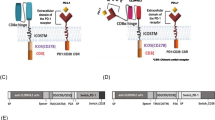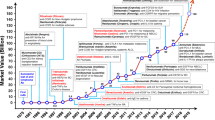Abstract
The insulin receptor (IR) is expressed ubiquitously in various tissues, where insulin exerts various biological effects on the target cells, such as cellular metabolic changes, cell proliferation and differentiation. Therefore, mimicry of insulin signaling would be a promising strategy to realize artificial control of such cellular fates. In this study, we constructed an antibody/insulin receptor chimera that enables to utilize any antigen as the ligand in principle. We constructed chimeric receptors consisting of anti-fluorescein single chain Fv (scFv), the extracellular D2 domain of erythropoietin receptor and the transmembrane/intracellular domains of IR (scFv-IR; S-IR). The function of S-IR was evaluated in terms of growth signal transduction in murine pro-B Ba/F3 cells and murine fibroblast NIH/3T3 cells. S-IR exerted IL-3-independent cell growth in Ba/F3 cells, while NIH/3T3 cells expressing S-IR acquired growth advantage over parental NIH/3T3 cells in a low-serum condition. S-IR induced phosphorylation of S-IR itself and key signaling molecules downstream of IR. Although antigen-independent activation was significantly observed, S-IR enabled specific amplification of the gene-transduced cells.





Similar content being viewed by others
References
Belfiore A, Pandini G, Vella V, Squatrito S, Vigneri R (1999) Insulin/IGF-I hybrid receptors play a major role in IGF-I signaling in thyroid cancer. Biochimie 81:403–407
Belfiore A, Frasca F, Pandini G, Sciacca L, Vigneri R (2009) Insulin receptor isoforms and insulin receptor/insulin-like growth factor receptor hybrids in physiology and disease. Endocr Rev 30:586–623
Chaika OV, Chaika N, Volle DJ, Wilden PA, Pirrucello SJ, Lewis RE (1997) CSF-1 receptor/insulin receptor chimera permits CSF-1-dependent differentiation of 3T3-L1 preadipocytes. J Biol Chem 272:11968–11974
Dawson JP, Weinger JS, Engelman DM (2002) Motifs of serine and threonine can drive association of transmembrane helices. J Mol Biol 316:799–805
Gorden P, Arakaki R, Collier E, Carpentier JL (1989) Biosynthesis and regulation of the insulin receptor. Yale J Biol Med 62:521–531
Goren HJ, White MF, Kahn CR (1987) Separate domains of the insulin receptor contain sites of autophosphorylation and tyrosine kinase activity. Biochemistry 26:2374–2382
Kaneko E, Kawahara M, Ueda H, Nagamune T (2012) Growth control of genetically modified cells using an antibody/c-Kit chimera. J Biosci Bioeng 113:641–646
Kawahara M, Nagamune T (2012) Engineering of mammalian cell membrane proteins. Curr Opin Chem Eng 1:411–417
Kawahara M, Kimura H, Ueda H, Nagamune T (2004a) Selection of genetically modified cell population using hapten-specific antibody/receptor chimera. Biochem Biophys Res Commun 315:132–138
Kawahara M, Ogo Y, Ueda H, Nagamune T (2004b) Improved growth response of antibody/receptor chimera attained by the engineering of transmembrane domain. Protein Eng Des Sel 17:715–719
Kawahara M, Ueda H, Nagamune T (2010) Engineering cytokine receptors to control cellular functions. Biochem Eng J 48:283–294
Kawahara M, Chen J, Sogo T, Teng J, Otsu M, Onodera M, Nakauchi H, Ueda H, Nagamune T (2011) Growth promotion of genetically modified hematopoietic progenitors using an antibody/c-Mpl chimera. Cytokine 55:402–408
Kobayashi S, Ji H, Yuza Y, Meyerson M, Wong KK, Tenen DG, Halmos B (2005) An alternative inhibitor overcomes resistance caused by a mutation of the epidermal growth factor receptor. Cancer Res 65:7096–7101
Liu W, Kawahara M, Ueda H, Nagamune T (2008) Construction of a fluorescein-responsive chimeric receptor with strict ligand dependency. Biotechnol Bioeng 101:975–984
Liu W, Kawahara M, Ueda H, Nagamune T (2009) The influence of domain structures on the signal transduction of chimeric receptors derived from the erythropoietin receptor. J Biochem 145:575–584
McKern NM, Lawrence MC, Streltsov VA, Lou MZ, Adams TE, Lovrecz GO, Elleman TC, Richards KM, Bentley JD, Pilling PA, Hoyne PA, Cartledge KA, Pham TM, Lewis JL, Sankovich SE, Stoichevska V, Da Silva E, Robinson CP, Frenkel MJ, Sparrow LG, Fernley RT, Epa VC, Ward CW (2006) Structure of the insulin receptor ectodomain reveals a folded-over conformation. Nature 443:218–221
Menting JG, Whittaker J, Margetts MB, Whittaker LJ, Kong GK, Smith BJ, Watson CJ, Zakova L, Kletvikova E, Jiracek J, Chan SJ, Steiner DF, Dodson GG, Brzozowski AM, Weiss MA, Ward CW, Lawrence MC (2013) How insulin engages its primary binding site on the insulin receptor. Nature 493:241–245
Morita S, Kojima T, Kitamura T (2000) Plat-E: an efficient and stable system for transient packaging of retroviruses. Gene Ther 7:1063–1066
Ohashi H, Kameda R, Nishikawa M, Kawagishi M, Liu YC (1994a) The c-kit receptor transduces the stem cell factor-triggered growth signal in murine interleukin-3-dependent cell line. Cytotechnology 16:27–35
Ohashi H, Maruyama K, Liu Y, Yoshimura A (1994b) Ligand-induced activation of chimeric receptors between the erythropoietin receptor and receptor tyrosine kinases. Proc Natl Acad Sci USA 91:158–162
Pandini G, Vigneri R, Costantino A, Frasca F, Ippolito A, Fujita-Yamaguchi Y, Siddle K, Goldfine ID, Belfiore A (1999) Insulin and insulin-like growth factor-I (IGF-I) receptor overexpression in breast cancers leads to insulin/IGF-I hybrid receptor overexpression: evidence for a second mechanism of IGF-I signaling. Clin Cancer Res 5:1935–1944
Sogo T, Kawahara M, Tsumoto K, Kumagai I, Ueda H, Nagamune T (2008) Selective expansion of genetically modified T cells using an antibody/interleukin-2 receptor chimera. J Immunol Methods 337:16–23
Sogo T, Kawahara M, Ueda H, Otsu M, Onodera M, Nakauchi H, Nagamune T (2009) T cell growth control using hapten-specific antibody/interleukin-2 receptor chimera. Cytokine 46:127–136
Soos MA, Whittaker J, Lammers R, Ullrich A, Siddle K (1990) Receptors for insulin and insulin-like growth factor-I can form hybrid dimers. Characterisation of hybrid receptors in transfected cells. Biochem J 270:383–390
Soos MA, Field CE, Siddle K (1993) Purified hybrid insulin/insulin-like growth factor-I receptors bind insulin-like growth factor-I, but not insulin, with high affinity. Biochem J 290:419–426
Tanaka K, Kawahara M, Ueda H, Nagamune T (2009) Selection and growth regulation of genetically modified cells with hapten-specific antibody/receptor tyrosine kinase chimera. Biotechnol Prog 25:1138–1145
Taniguchi CM, Emanuelli B, Kahn CR (2006) Critical nodes in signalling pathways: insights into insulin action. Nat Rev Mol Cell Biol 7:85–96
Ullrich A, Gray A, Tam AW, Yang-Feng T, Tsubokawa M, Collins C, Henzel W, Le Bon T, Kathuria S, Chen E et al (1986) Insulin-like growth factor I receptor primary structure: comparison with insulin receptor suggests structural determinants that define functional specificity. EMBO J 5:2503–2512
Yang J, Symes K, Mercola M, Schreiber SL (1998) Small-molecule control of insulin and PDGF receptor signaling and the role of membrane attachment. Curr Biol 8:11–18
Acknowledgments
We are grateful to Dr. Toshio Kitamura for a retroviral expression system. This work was supported by Grants-in-Aid for Challenging Exploratory Research 23656516 (M.K.) from the JSPS, Japan, by the Program for Promotion of Basic and Applied Researches for Innovations in Bio-oriented Industry (BRAIN) (M.K.) and by the Global COE Program for Chemistry Innovation.
Author information
Authors and Affiliations
Corresponding author
Rights and permissions
About this article
Cite this article
Nakabayashi, H., Kawahara, M., Tanaka, K. et al. Construction of antibody/insulin receptor chimera for growth induction of mammalian cells. Cytotechnology 65, 945–953 (2013). https://doi.org/10.1007/s10616-013-9571-5
Received:
Accepted:
Published:
Issue Date:
DOI: https://doi.org/10.1007/s10616-013-9571-5




